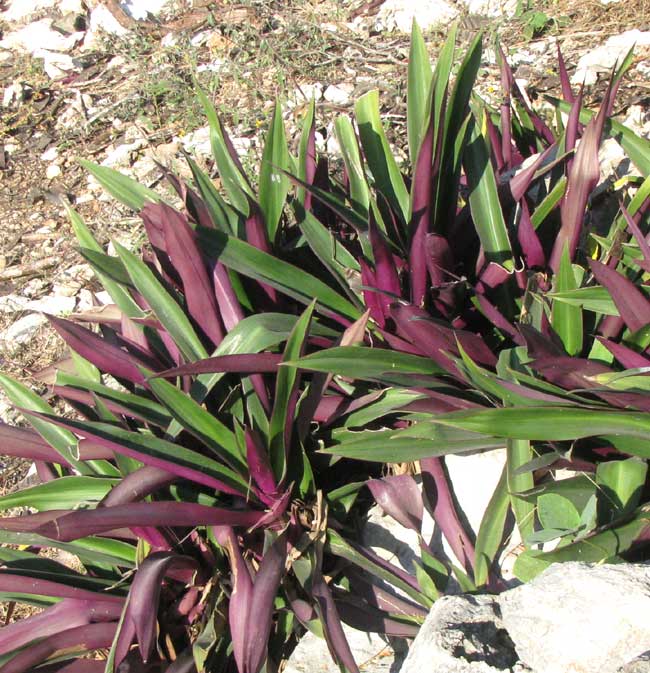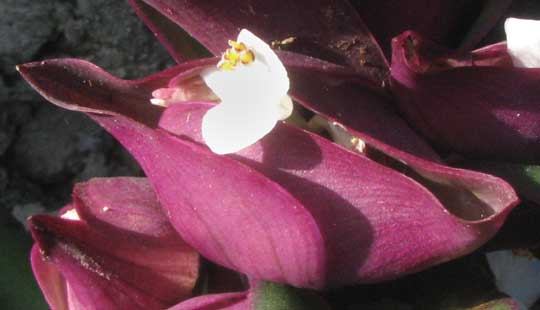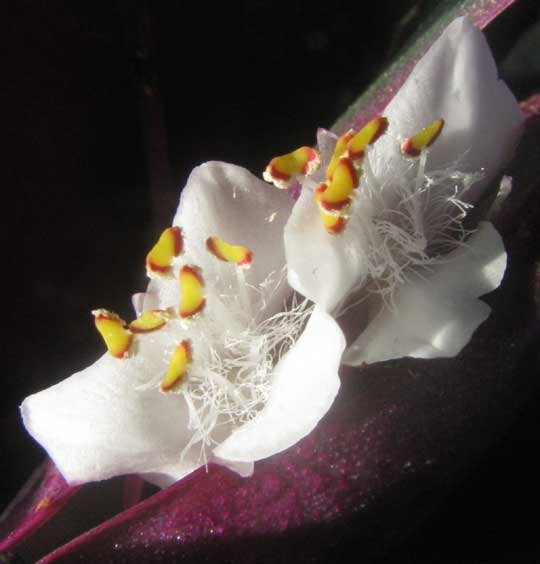Excerpts from Jim Conrad's Naturalist Newsletter

from the February 6, 2012 Newsletter issued from Hacienda Chichen Resort beside Chichén Itzá Ruins; limestone bedrock; elevation ~39m (~128ft), N20.675°, W88.569°; central Yucatán state, MÉXICO
BOAT LILY
Two variations are commonly known of the monocotyledonous Boat Lily, TRADESCANTIA SPATHACEAE {the other is shown below}. The two variations are so different from one another that it's hard to believe they're the same species. The variation with purple-bottomed leaves is shown on a colony growing wild on a weedy, limestone outcrop in Pisté above. Other variations have been developed as well.
Up North this variation with purple-bottomed leaves is marketed under many names, including Moses-in-a-Boat, Moses-in-the-Bulrushes, Men-in-a-Boat, Oysterplant and Boatplant, and it's often grown indoors in pots. It's a frost-intolerant member of the Spiderwort Family, the Commelinaceae. The species is native to Mexico, Central America and the Caribbean, and has escaped from cultivation in much of the world's tropics, including in Florida and Louisiana, where sometimes it creates such a dense groundcover that it prevents seeds of native plants from germinating on the forest floor.
You can understand why some of the English names mention a boat and passengers when you see how its flowers are subtended by modified leaves, or bracts, below:

A close-up of two flowers, each with three white petals and six stamens, the stamens' stems, or filaments, overgrown with tangles of long, soft hairs is shown below:

Various cultures have used the plant's watery juice cosmetically. The juice irritates skin, reddening it, so people wanting their cheeks to shine with a rosy glow daub them Boat-Lily juice.
In the old days Tradescantia spathacea was known as Rhoeo discolor.
from the October 6, 2008 Newsletter written in Sabacché; ~N20.66°, ~w89.37°, elev. ~10m (~63ft); issued in Mérida, Yucatán, MÉXICO
BOAT LILY
Another sinkhole-bottom denizen of Black Vulture Cenote was the familiar-looking Boat Lily shown below:

It's familiar-looking because it's often grown as an ornamental in gardens here and in greenhouses and as potted plants beyond the tropics. It's TRADESCANTIA SPATHACEA, a member of the Spiderwort Family, the Commelinaceae. Around here you find it only in cenotes and the most shaded, sheltered parts of the scrub.
Most Boat Lilies have leaves that are deep purple below but these are clearly green. The Flora of North America states that sometimes the lower leaf surface is not purple, so here we have one of those exceptions.
Note the curious manner in which the thumbnail-size, white blossoms emerge from the leaf bases. A close-up of a flower showing something else special about it is below:

Can you see how the blossom arises from what looks like a green, folded-together leaf? That's a modified leaf referred to as a bract and it protects the flowers. The delicate blossom develops inside the folded bract, the day it opens it barely pokes its head above the bract's rims, then after pollination its pedicel bends the maturing ovary backward out of the way, to make place for the next flower. In the picture you can see bent-back pedicels to the right, behind the flower. You may recall similar bracts subtending flowers in various dayflowers, genus Commelina, we've run into. Dayflowers belong to the same family. The way the flowers are cradled inside the folded bracts has given rise to some of the plant's many names -- Boat Lily, Moses-in-a-boat, Oysterplant, Boatplant.